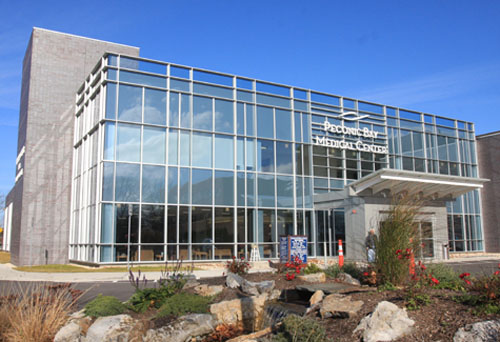Mixed grades for hospitals on patient surveys

Hospitals routinely ask patients for feedback on their inpatient experiences. Since 2006, that effort has included a standardized patient survey developed by the Centers for Medicare & Medicaid Services that allows both statewide and nationwide hospital rankings and comparisons.
That survey, known as the Hospital Consumer Assessment of Healthcare Providers and Systems Survey (HCAHPS), recently took on a new importance. Eastern Long Island Hospital CEO Paul Connor said HCAHPS has now been linked to the amount of Medicare reimbursement a hospital ultimately receives from the federal government.
While a good score or high rank still offers bragging rights, less impressive performance could now cost a hospital up to 1 percent of its reimbursements. That variable doubles to 2 percent next year, Mr. Connor said.
“That’s 1 or 2 percent of the total revenue stream when we already basically break even, so positive responses are very important for us because there’s a lot of risk there,” he said.
Neither ELIH nor Peconic Bay was able to provide total dollar amounts for 2012 inpatient Medicare/Medicaid volume, which would indicate how much each hospital stands to lose as a result of the new process.
“It’s really too early to determine the loss or gain for any hospital because CMS is still crunching the numbers for 2012,” said Janine Logan, a representative of the Northern Metropolitan Hospital Association.
However, Under the Affordable Care Act, commonly referred to as Obamacare, 1 percent of Medicare’s 2013 hospital reimbursement is already being withheld to allow CMS time to fully assess survey results and rate hospital performance.
How much of that 1 percent a hospital will ultimately forfeit, Mr. Connor said, depends not only on HCAHPS, which counts for 30 percent of the decision, but also on its performance in a separate rating on a dozen core measures for patient care, which counts for 70 percent of the outcome. Those core measures include whether heart attack patients receive proper medication within 30 minutes of arrival and whether pneumonia patients get the most appropriate initial antibiotics.
Asked about his hospital’s performance on the more heavily weighted core measures, Mr. Connor said ELIH is “basically consistent with what the core standards are. I think we’re performing at the standards, if not better.”
The current HCAHPS results show that ELIH exceeded state and national averages on five of the 10 survey questions. Peconic Bay Medical Center in Riverhead fell short of state and national averages on all but one question, where it surpassed ELIH by a percentage point.
Of ELIH patients surveyed 79 percent reported they would “definitely” recommend the hospital to others.
“We’ve always felt we’ve had a very positive, high-touch culture here and that’s a reflection of the community,” Mr. Connor said. “It’s nothing I’ve done. It was here before I got here, though we do take an opportunity to foster it.”
As far as improvements go, he said, “We can always use improvement in communicating to the patient,” he said.
Another area in which Mr. Connor said improvement could be made concerned noise levels, a problem he said is common at most hospitals.
ELIH got its lowest score in this area, with only half the respondents reporting that the area around their room was always quiet at night. Still, that 50 percent rating exceeded New York’s state average of 49 percent. The national average was 60 percent.
“Hospitals are notoriously noisy in the evenings, which is an industry-wide problem and though I think we’ve done marginally better [than other hospitals] I think it’s something we can always improve,” Mr. Connor said.
Peconic Bay Medical Center also received its lowest score on this question, coming in at 40 percent.
ELIH’s second-lowest score came on the question of whether staff always explained medications before administering them. Here, its results matched the state average, with 58 percent reporting that such explanation were made, but fell short of the national average of 63 percent.
Peconic Bay Medical Center also received a lower-than-average 52 percent score in this category.
On the question of whether patients received information about what to do during recovery at home, 84 percent of PBMC patients said they received that information, which matched the nationwide average and beat ELIH by one percentage point. New York State’s average was 81 percent.
Repeated efforts to reach Peconic Bay Medical Center president and CEO Andy Mitchell for comment were unsuccessful.
HOW THEY FARED
Peconic Bay Medical Center
Best Scores
• 84 percent reported that YES, they were given information about what to do during their recovery at home. (N.Y., 81; U.S., 84)
• 73 percent reported that their doctors “always” communicated well. (N.Y., 77; U.S., 81)
Worst Scores
• 40 percent reported that the area around their room was “always” quiet at night. (N.Y., 49; U.S., 60)
• 46 percent reported that they “always” received help as soon as they wanted it. (N.Y., 59; U.S., 66)
Eastern Long Island Hospital
Best Scores
• 83 percent reported that YES, they were given information about what to do during their recovery at home. (New York State average, 81; U.S. average, 84)
• 79 percent reported that YES, they would definitely recommend the hospital. (N.Y., 64; U.S., 70)
Worst Scores
• 50 percent reported that the area around their room was “always” quiet at night. (N.Y., 49; U.S., 60)
• 58 percent reported that staff “always” explained a medicine before giving it to them. (N.Y., 58; U.S., 63)








